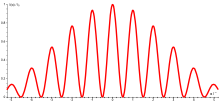Taylor experiment (physics)
The Taylor experiment by physicist Geoffrey Ingram Taylor from 1908 is a diffraction experiment with extremely low light. It shows that light moves neither as a classical particle nor as a classical wave . Historically, it was the first experiment in which the light field between the light source and screen contains less than one photon on average .
Historical classification
After Thomas Young was able to show and explain diffraction of light at double slits in 1802, the idea of light as a wave phenomenon had largely established itself. Light was viewed as a classic wave and the light colors could be assigned wavelengths . Only the " ether " assumed by Christiaan Huygens as the carrier of these "light waves" had yet to be found.
At the end of the 19th century this view was called into question by experimental results. The systematic investigation of the photoelectric effect by Heinrich Hertz and Wilhelm Hallwachs in 1887 indicated a particle nature of light. In addition, hypotheses based on the laws of classical mechanics and electrodynamics about the radiation spectrum of the ideal radiant heater only partially matched the empirically determined measured values.
Both effects could be explained at the beginning of the 20th century by the assumption that light spreads in fixed energy portions, so-called quanta . In 1900 Max Planck described the ideal heat radiator using Planck's law of radiation and Albert Einstein provided an explanation for the photo effect in his light quantum hypothesis in 1905 . Nowadays these theoretically predicted light quanta are known as photons.
Test execution
The experiment was carried out to verify a theory of the Nobel Prize winner and discoverer of electrons Sir Joseph John Thomson , according to which the energy distribution along the wavefront should take place unevenly. Regions with maximum energy should be separated from each other by undisturbed areas. When the light intensity is reduced, these regions should be further separated from one another - however, the amount of energy in the regions with maximum energy should not be changed because of the indivisibility of the quanta. Thomson also believed that the usual diffraction phenomena are limited at extremely low intensities.
In the original setup of the experiment, the light from a gas flame was weakened by soot-blackened plates of different degrees of blackness and bent at a needle tip. The result was recorded on long-term exposed photographic plates. The maximum exposure time used was about three months and regarding light intensity, Taylor writes, “The amount of energy that falls on the photographic plate during the longest exposure time is the same as that given off by a normal candle that is a little further away than a mile. "
With short exposure times, the photographic plates showed a grainy and stochastic pattern. With longer exposure times, however, the same interference pattern developed as with short exposure times and high light intensity.
In a modern version of this experiment, a laser beam weakened by a gray filter is used as the light source , which is bent at a double slit . Instead of the photo plates, a CCD photo sensor can be used, which records the diffraction pattern typical of double slits. If the film is played back very slowly, the graininess and the stochastic behavior can be recognized.
Importance of the experiment
The Taylor experiment from 1908 shows what Planck and Einstein formulated. The light consists of individual photons , which, unlike classical particles, cannot be localized. It is therefore impossible to predict the location and trajectory of a single photon (see Heisenberg's uncertainty principle ). The classic mechanics completely fail here. With the help of the wave theory for light, however, the probability of its presence can at least be predicted extremely precisely, so that when many photons are considered according to the law of large numbers, a distribution pattern is created that agrees with the observations. This shows that photons are quantum objects whose wave function can show interference.
Others
In 1961, Claus Jönsson at the University of Tübingen succeeded in carrying out the same experiment with electrons instead of photons , which shows that electrons also cause quantum phenomena.
Since the implementation of the Taylor experiment in its modern form can also be handled with school resources, it is recommended by the Pedagogical Center Rhineland-Palatinate (PZ) for the physics curriculum for upper secondary level :
“From a didactic point of view, the Jönsson and Taylor experiments function as key experiments that 'leave the quantum phenomena intact' and do not concentrate exclusively on the so-called 'particle aspect' or the so-called 'wave aspect'. An adequate, i.e. H. A suitable understanding of quantum phenomena can be built up if 'wavy', 'grainy' and 'stochastic' are considered right from the start and left completely free. Jönsson and Taylor experiments offer that. "
literature
- Geoffrey Ingram Taylor: Interference fringes with feeble light . In: Proceedings of the Cambridge Philosophical Society , Volume 15, 1909, pp. 114-115
- Claus Jönsson: Electron interference on several artificially produced fine slits . In: Zeitschrift für Physik , 161, 1961, pp. 454–474
Web links
- Taylor experiment ( Memento from June 18, 2002 in the Internet Archive ) (real experiment with video)
- Original work by Taylor (German translation and English original)
Individual evidence
- ↑ Josef Leisen: Quantum Physics / Micro Objects. (PDF; 661 kB) (No longer available online.) In: PZ-Information 2/2000. Pedagogical Center Rhineland-Palatinate, 2000, archived from the original on December 26, 2015 .
